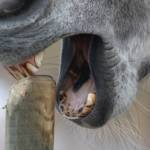Ventilation in Horse Trailers

It may be necessary to transport horses for many reasons: training, pleasure riding, competition, breeding, sales, veterinary treatment, and so on. Owners want to make the experience as stress-free, safe, and healthy as possible for their equine passengers. Avoiding extreme cold is usually not a problem, as horses produce a great deal of body heat, especially if more than one horse is being moved. A situation that is potentially harmful is exposure to hot air that is full of small particles that can irritate the horse’s respiratory system. Continuous air exchange can prevent overheating and reduce exposure to dust, bacteria, and mold. Keeping air moving can help to ensure that horses will travel in reasonable comfort and arrive at their destination in good health.
This study was performed to assess air exchange rates in trailers with various ventilation port configurations and with differing numbers of horses being transported. Researchers looked at air movement and temperature in several areas of the trailer, and also quantified the effect of vehicle speed, window openings, and number of horses on air exchange.
How was the study performed?
Air exchange rate was measured at ten locations in a horse trailer, both with and without horses present, by use of tracer gas concentration decay tests. Determinations of exchange rate were made at three different speeds to simulate driving in town, on rural roads, and on limited-access highways.
Three ventilation arrangements were also tested: windows and forward-facing roof vents closed; windows open and roof vents closed; and windows and roof vents open. Four mature geldings (three Thoroughbreds and one Standardbred) were used in the study. All horses had been transported many times and were familiar with the particular trailer used in the study.
The trailer was a four-horse, slant-load, goose-neck model with a rear window, a window at the head and tail of each horse, and a forward-facing roof vent over each horse’s head. Total area of all openings was 1.05 square meters (11.86 square feet). Horses were placed with their heads angled toward the driver’s side of the vehicle. The stalls were numbered one through four beginning at the front of the trailer, and were divided by moveable partitions attached to the driver’s side.
Tracer gas concentration decay measurement was the method used to determine air flow because this method is the only analysis appropriate for air spaces with multiple inlets and outlets. Only relative changes in concentration are required to determine exchange rate. Concentration was measured every ten seconds by infrared sensors spaced at various locations inside and outside the trailer. Carbon dioxide, the tracer gas, was injected into the trailer until the concentration reached equilibrium at the upper end of the sensor range, and dilution was measured as fresh air entered the trailer.
Outside air temperature was measured by a sensor that determined both temperature and relative humidity. Temperature in the trailer was measured by thermocouples located with the carbon dioxide probes. At the start of each round of measurements, the trailer was allowed to achieve target speed and remain at that speed for two to three minutes to allow air flow patterns to develop. Carbon dioxide was injected throughout this period to promote dispersion and mixing within the trailer. Concentrations above 5000 ppm (the suggested human exposure limit) were avoided. Injection was stopped when the calibration level of the sensors was reached, and the concentration was allowed to decay to equilibrium while the vehicle maintained a constant speed.
What results were found?
At the lowest speed that simulated town driving, no valid data were collected when horses were in the trailer. Injection of carbon dioxide, exhalations of the horses, and low rates of air exchange combined at this speed to cause the sensors to exceed calibration limits.
As expected, increasing speed generally resulted in more air exchange, and air exchange was also enhanced when all windows and vents were open. Air exchange varied by location when horses were in the trailer, with the lowest exchange rates found in stall 1 (nearest to the front of the trailer).
Even at the highest speed and with all windows and vents open, average air exchange rates were only about half those recommended for stabled horses. Although outside temperature never exceeded 28º C. (82º F.) during the study, heat stress conditions (defined as air temperature exceeding 30º C. /86º F.) were observed inside the trailer. Horses in stall 1 routinely showed more sweating than those in other locations.
What do the results tell us about keeping horses healthy during transport?
Based on analysis of data, the trailer used in this study was judged to be under ventilated.
An independent but similar study found less variation of air exchange by location when upper rear trailer doors were removed. Ideas for providing better air exchange and minimizing heat stress of transported horses include increasing window size and opening or removing upper rear doors. Owners should look for maximum ventilation when they are comparing trailer models prior to purchase. In this trial, data were collected for only two conditions, empty trailer or trailer holding four horses. When four horses were transported, air exchange rate was lower in front stalls than in rear stalls. Putting the smallest or leanest horse in the first stall might be a way to avoid overheating during transport.
It is safe to assume that increased air exchange minimizes the buildup of dust and mold spores in trailer air, but drafts due to increased speed can blow particles of dust, hay, and straw through the trailer. Putting fly masks on transported horses can help to keep dust and airborne material from causing eye injuries.
The full text of this report can be found in Transactions of the American Society of Agricultural and Biological Engineers, Vol. 49 (1): 193-201. The study “Air exchange rate in a horse trailer during road transport,” was conducted by J.L. Purswell, R.S. Gates, L.M. Lawrence, J.D. Jacob, T.S. Stombaugh, and R.J. Coleman.








